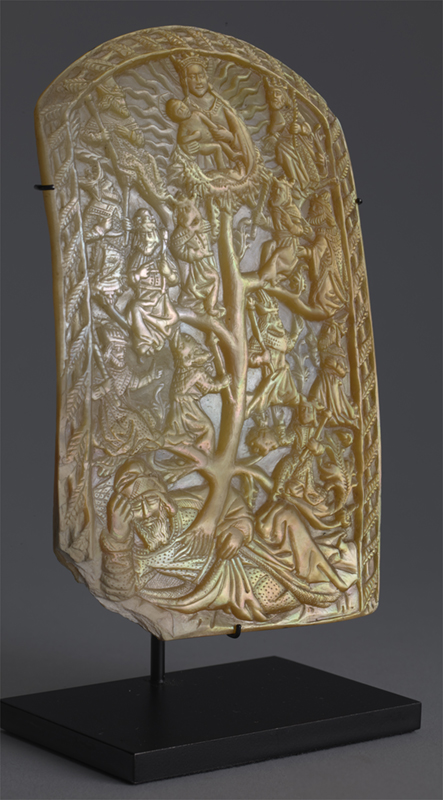In Focus: New Views of the Middle Ages: Highlights from the Wyvern Collection
By Bowdoin College Museum of Art
Plaque with the Tree of Jesse, 1500, present-day Germany or France, Mother-of-pearl. Wyvern Collection
New Views of the Middle Ages: Highlights from the Wyvern Collection presents nearly fifty works of medieval art, including several east African and west Asian pieces in addition to European items, from the sixth through the sixteenth centuries. The exhibition will be installed at the Museum from September 8, 2020 until late August 2021, and will be available for study by students and faculty. With the museum closed to the public for the foreseeable future, a companion website is now available for virtual visitors. The website features images of all the works in the show along with maps and student commentary about selected masterworks. The exhibition catalogue will be available for purchase from the Bowdoin store this fall.
The works in this show have come to Bowdoin as part of a long-term loan from the Wyvern Collection, one of the most important private collections of medieval art today, and many of these works are on public view for the first time. The objects in this exhibition present us with direct and tangible links to the past, and their presence on the Bowdoin campus offers an extraordinary opportunity for students, faculty, and the Brunswick community to interact with and learn from these artifacts, while being inspired by their beauty. The works of medieval art are of the superlative quality of objects often found only in the civic museums located in large metropolitan areas, such as New York, Chicago, or Los Angeles. Bringing these high-caliber works to the Bowdoin College Museum of Art has already had an enormous impact on teaching at Bowdoin, students worked closely with faculty and museum staff in preparing the exhibition and the accompanying catalogue.
New Views of the Middle Ages has been structured around three major themes: the role of specific materials and skills in the creation of medieval art, the fundamental importance of larger global networks in the creation of art in medieval Europe, and the ways in which medieval people used works of art to explore and define their identities and selves.
One piece in the show that brings all of these themes together is a small mother-of-pearl plaque made around the year 1500, carved with an image known as The Tree of Jesse, a popular Christian devotional scene based on the biblical Book of Isaiah. This piece was produced in Europe and the image is modeled on illustrations in early printed books from France, but the material from which it was fashioned was imported from much further afield, probably the Red Sea or the Indian Ocean. Mother-of-pearl represented an exotic material for European audiences and required a great deal of skill and training to carve. The value and rarity of the material, which conveyed important symbolic meanings related in part to Christian beliefs surrounding the human and divine aspects of Jesus Christ, would have made this an object of pride for a wealthy owner, while the Christian subject matter would have affirmed the owner’s faith.
Like the mother-of-pearl plaque, each of the works in this show can offer many inroads to a richer understanding of the medieval past, of the artists and patrons of that period, and of the ways in which art can be used to create and project important social values across history.
Kate Gerry
Visiting Assistant Professor of Art History, Art History
Guest Curator for the Exhibition